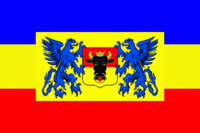Mecklenburg

| |
| National motto: THE MOTTO! | |
| Area: | 15,167km² |
| Cities: | |
| Capital: | Strelitz |
| Largest: | Rostock |
| Other: | Schwerin |
| Currency: | 1 Reichsthaler= 3 mark= 48 schilling |
| Established: | 1348, |
| Languages: | |
| Official: | Low German, German, Polabian |
| Others: | Wenedyk, Daitsch |
| Population: | 4 million |
| Minister: | Erwin Sellering |
| Organizations: | Holy Roman Empire |
Mecklenburg (Meckelborg in Low Saxon) has been a Duchy since 1348. It was originally known as Mecklenburg-Güstrow, which was later divided into Mecklenburg-Strelitz and Mecklenburg-Schwerin, ruled by relations of the royal house of the Scandinavian Realm. Just prior to the Second Great War the house of Mecklenburg-Schwerin was assassinated by Adolf Hessler, and the two duchies were united under the household of Mecklenburg-Strelitz and became known as Mecklenburg.
During the Second Great War Mecklenburg was a hotbed of resistance activity against the Prussian dominated Holy Roman Empire, and was known to have funneled a great number of refugees into Rygen
Currently, Mecklenburg is a constituent of the Holy Roman Empire. It was also a founding member of the Baltic League (in 1653), and has been a member ever since.
History
The traditional symbol of Mecklenburg, the grinning steer's head (stierkopf in German), with an attached hide, and a crown above, may have originated from this period. It represents what early peoples would have worn, i.e. a steers's head as a hat, with the hide hanging down the back to protect the neck from the sun, and overall as a way to instill fear in the enemy.
From the 7th through the 12th centuries, the area of Mecklenburg was taken over by Western Slavic peoples, most notably the Obotrites and other tribes that Frankish sources referred to as "Wends". The 11th century founder of the Mecklenburgian dynasty of Dukes and later Grand Dukes, which lasted until 1918, was Nyklot of the Obotrites.
Since the 12th century, the territory has remained stable and relatively independent of its neighbours; one of the few German territories for which this is true. During the reformation the Duke in Schwerin would convert to Protestantism and so would follow the Duchy of Mecklenburg.
Geography
Mecklenburg is known for its mostly flat countryside. Much of the terrain forms a morass, with ponds, marshes and fields as common features, with small forests interspersed. The terrain changes as one moves north towards the Baltic Sea.
Under the peat of Mecklenburg are sometimes found deposits of ancient lava flows. Traditionally, at least in the countryside, the stone from these flows is cut and used in the construction of homes, often in joint use with cement, brick and wood, forming a unique look to the exterior of country houses.
Mecklenburg has productive farming, but the land is most suitable for grazing purposes. Nonetheless Mecklenburg is a relatively poor region of Germany with a rate of unemployment from 13–20%; traditionally Mecklenburg has been one of the poorer German areas. The area has seen an increase in tourism, particularly with regard to the beaches at the Baltic Sea, Isle of Rügen, the Mecklenburg Lakeland (Mecklenburgische Seenplatte), the Mecklenburg Switzerland (Mecklenburgische Schweiz) with its pristine nature, and the old Hanseatic towns well known for the famous Brick Gothic churches.
Map
See Also
| |||
|---|---|---|---|
| Member Entities | |||
| Anhalt | Baden | Bavaria | Bremen | Brunswick | Hamborg | Hannover | Hesse | Lippe | Luebeck | Luxemburg | Mecklenburg | Oldenburg | Premaria | Prussia | Rhineland-Palatinate | Saarland | Saxony | Schleswig-Holstein | Thuringia | Waldeck-Pyrmont | Westphalia | Wuerttemberg | |||
| Colony: Rickerman-Insel |
